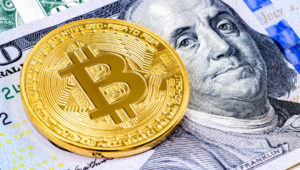Ahead of the Curve: The Cryptocoin Conspiracy – Part 2

Last week I gave an oversimplified explanation of how bitcoins and other cryptocurrencies work, how they do not in practice offer most of the advantages their purveyors claim, and how they do offer a shroud of secrecy much prized by drug financiers, hackers, tax evaders, and other crooks.
The disadvantage that should worry everyone the most, though, is that widespread adoption of cryptocurrency could cripple the ability of governments to control monetary policy. Even though your brain may still be hurting from last week’s description of how cryptocurrency works (as mine is), allow me to give you my layman’s description of monetary policy as well.
Here goes:
The amount of “money” circulating in an economy at any given time matters. Suppose a simple economy has a grand total of ten widgets for sale, and ten dollars in circulation. Each widget will therefore cost a dollar. If some bureaucrat decides to print another dollar, then you get inflation higher-priced widgets) which, at least in large doses, is bad. If somehow a dollar gets removed from the system, then you get a recession, because people aren’t able to buy all the widgets they need. This is even more painful, especially for the poor. It is critically important, for reasons roughly similar to this model (but far more complicated) for the government to manage the growth of the money supply as precisely as it can, and link it carefully to the growth in economic output.
That is exactly what the Federal Reserve System has been doing for the last 104 years. With two big exceptions—the Great Depression of the 1930s, and the “stagflation” of the 1970s— they’ve been pretty darned good at it. Even those two exceptions have been useful as learning opportunities, with mountains of PhD theses teaching policymakers today how best to handle such crises in the future. The 2008 financial breakdown is a good example. A lot of people got hurt, but things were not nearly as bad as they might have been, precisely because the Federal Reserve took dramatic, unprecedented steps to get the money supply back to a good spot. All the learning derived from this episode will further guide policymakers the next time we are hit with economic crisis.
The Fed has the tools to do this because most US “money” today consists of debt instruments issued by the Fed itself. If they want to nudge up the money supply a little, they buy government debt, for Federal Reserve note “money.” If they want to tamp down the money supply a little, then they sell government debt, taking more “money” out of circulation.
But what happens if “money” no longer consists of Federal Reserve notes? One futurist boldly predicts that “cryptocurrencies are going to displace roughly 25 percent of national currencies by 2030.” Others note that the very reason for the creation of cryptocoins back in 2009 was a “cypherpunk” distrust of the whole premise of central banking. Libertarians wanted to remove the so-called evil of human influence from economic management, trusting the hidden hand of an unfettered marketplace to lead us all to Valhalla.
What happens is that all the tools sharpened by the Fed over the past century suddenly become blunted, and all the learning accumulated over that period swirls right down the drain. One economist predicts that such a loss of fine-tuning control would “increase the amplitude of the business cycle.” Real-talk translation: there will be more wild inflations followed by more depressions, and governments won’t be able to do a darned thing about them.
The libertarian instinct behind the cryptocoin fervor is similar to that driving the affection for assault weapons. The government can’t be trusted. It’s out to get us and make us all slaves of the elite. We should all live in fortified compounds, free of societal restraint. Especially any restraint over our money. Never mind that government monetary management has produced results far superior to the centuries of boom and bust that preceded 1913. It’s the principle that counts.
Some governments are waking up to the dangers of cryptocurrencies in their present free-for-all form. Vietnam has banned payments in cryptocurrencies, South Korea has banned initial coin offerings and anonymous accounts, and China is cracking down in numerous ways. Other governments, including ours, are urgently studying cryptocoin regulation, which may be on the G20 agenda in Argentina next month. My fear is that the bigger cryptocurrency gets, the more legislators (and their backers) will own it, and the harder it will become to regulate it in a way that benefits all of us rather than a handful of us.
The distributed ledger technology (“blockchain”) underlying cryptocurrencies holds great promise, in lots of different fields. Sweden, for example, is developing a blockchain land ownership registry. I know someone who’s been embroiled in a dispute over ownership of a narrow but critical strip of undeveloped land for years on end. A blockchain ownership registry in place fifty years ago would have alleviated all sorts of present day angst and attorneys’ fees. Blockchain may even be useable as a currency someday. But only if there are safeguards in place to make it less useful for criminals, and a seamless integration with traditional money so that monetary authorities can still do their jobs.
